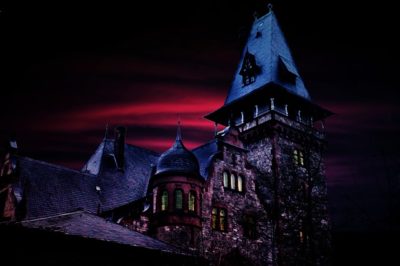
Netflix just launched its latest series, The Haunting of Hill House, an atmospheric, timely addition to its October fare. So it seems like a good time to resurrect that show’s source material as we set out the pumpkins, coat the door with ectoplasm, and cob the webs for All Hallows Eve.
In an earlier column, I talked about setting as a literary character in itself, something inseparable from the story. I used Manderley, in Daphne du Maurier’s Rebecca (1938), to illustrate the idea.
Now let’s look at Shirley Jackson. Her novel, The Haunting of Hill House (1959) harkens back to Rebecca and to the Gothic literature of the 18th and 19th centuries, what with creaking, dripping, dusty old mansions, with odd angles and architecture, and things that slither unseen in the shadows. But Jackson was way too smart to stick to conventions and tropes, and impregnates Hill House with palpable dread in its very bricks, with a true life of its own. Stephen King readily acknowledges his debt to Jackson and borrowed liberally from the novel for The Shining, Salem’s Lot, It, and others.
Jackson leads with her write and opens the novel thusly
No live organism can continue for long to exist sanely under conditions of absolute reality; even larks and katydids are supposed, by some, to dream. Hill House, not sane, stood by itself against its hills, holding darkness within; it had stood so for eighty years and might stand for eighty more. Within, walls continued upright, bricks met neatly, floors were firm, and doors were sensibly shut; silence lay steadily against the wood and stone of Hill House, and whatever walked there, walked alone.
That! That’s how setting becomes character, a character with a personality and a soul and a backstory, however dark and disturbed. The TV series’ writers wisely chose to also open with that paragraph.
This establishment of setting-as-character performs triple duty by painting a helluva foreshadowing. It allows Jackson to get to the meat of the story, that of Eleanor Vance, an insecure, repressed young woman who has never been allowed to really live (much like the second Mrs. de Winter in Rebecca), a woman desperate to reboot her life. Eleanor has always lived in the shadows of her mother and sister, and on impulse jumps at the opportunity when invited to spend the summer in Hill House as a part of an investigation into the reputed psychic phenomena associated with the place.
A contrasting character foil to Eleanor is provided by Theodora, an artist unafraid of life. Interestingly, given societal attitudes at the time of publication, Theodora is a lesbian, although it’s never overtly stated. Jackson makes a bold move and writes Theo sympathetically.
Jackson teaches great lessons in characterization. She creates a deeply flawed, insecure protagonist in Eleanor, makes the setting (Hill House) mirror her and become the antagonist, and contrasts them both against the flamboyant Theodora. The other main characters, all men, seem almost superfluous. They throw in a bit of mumbo-jumbo and conflict at every turn, but the narrative circles back to Eleanor and Hill House, and to Theo to a lesser degree. After a while Eleanor and Hill House become almost inseparable, as if becoming a single entity. And maybe they are.
Long before the Netflix series, the novel was adapted to the big screen twice. The first, the 1963 movie, remains largely faithful to the novel, although hampered by a scene which seems to cast Theo’s lifestyle in a negative light. The second version came in 1999 with the over-the-top special effects remake, an unfaithful version redeemed a bit by its more sympathetic portrayal of Theo. The new Netflix series bears little resemblance to the original novel. Not saying that’s bad; the show grabs you by the throat with icy fingers, but takes a wide detour while paying homage to Jackson’s novel and the earlier movies.
For a peak at the 1963 flick, enter here to walk alone in Hill House. Happy Halloween!

Rob McCabe
The Haunting of Hill House is by far, the creepiest haunted house novel ever written, ( with Richard Mattheson’s Hell House coming in a close second). Jackson creates a living, evil entity in Hill House, which begins and ends with the same paragraph, bringing the novel to a disturbing conclusion. Robert Wise’s film version is the closest to Jackson’s novel, except he changed the sexual Dynamics by making the Dr. character younger, and his wife a bitter bitch, rather than the psychic enthusiast who comes with planchette and her companion to speak to the Spirits. There are a few other differences from the transition from book to film, but the 1963 version is far superior to the 1990s remake. By the way…Jackson loved Wise’s film version, which is high praise indeed.
Ken Pelham
Rob, thanks for weighing in!
Agreed, the 1963 film is a pretty faithful adaptation, but I’ve always been at a loss as to why some of the changes were made. I don’t think they made the story more “visual,” which is what filmmakers usually claim. How do name changes make something more visual?
Anyway, I quibble. It’s a good movie.